Report on Entrepreneurial Ventures, SMEs, and Social Economy Impact
VerifiedAdded on 2023/01/12
|11
|2587
|20
Report
AI Summary
This report delves into the realm of entrepreneurship and small business management, exploring various aspects of entrepreneurial ventures. It begins by defining entrepreneurship and examining different types of ventures, including small businesses, social enterprises, and large enterprises, along with their respective typologies such as lifestyle and growth firms. The report then differentiates and compares these ventures based on factors like scale, purpose, and organizational characteristics. A significant portion of the report is dedicated to interpreting statistics to illustrate the impact of micro and small businesses on the economy, considering local, regional, and national impacts. The importance of SMEs and startups in fostering social economic growth is also highlighted, emphasizing their role in employment generation, raising living standards, and driving economic growth. The report concludes by summarizing the key findings and emphasizing the significance of entrepreneurship in driving innovation and economic development.

Entrepreneurship and Small
Business Management
Business Management
Paraphrase This Document
Need a fresh take? Get an instant paraphrase of this document with our AI Paraphraser
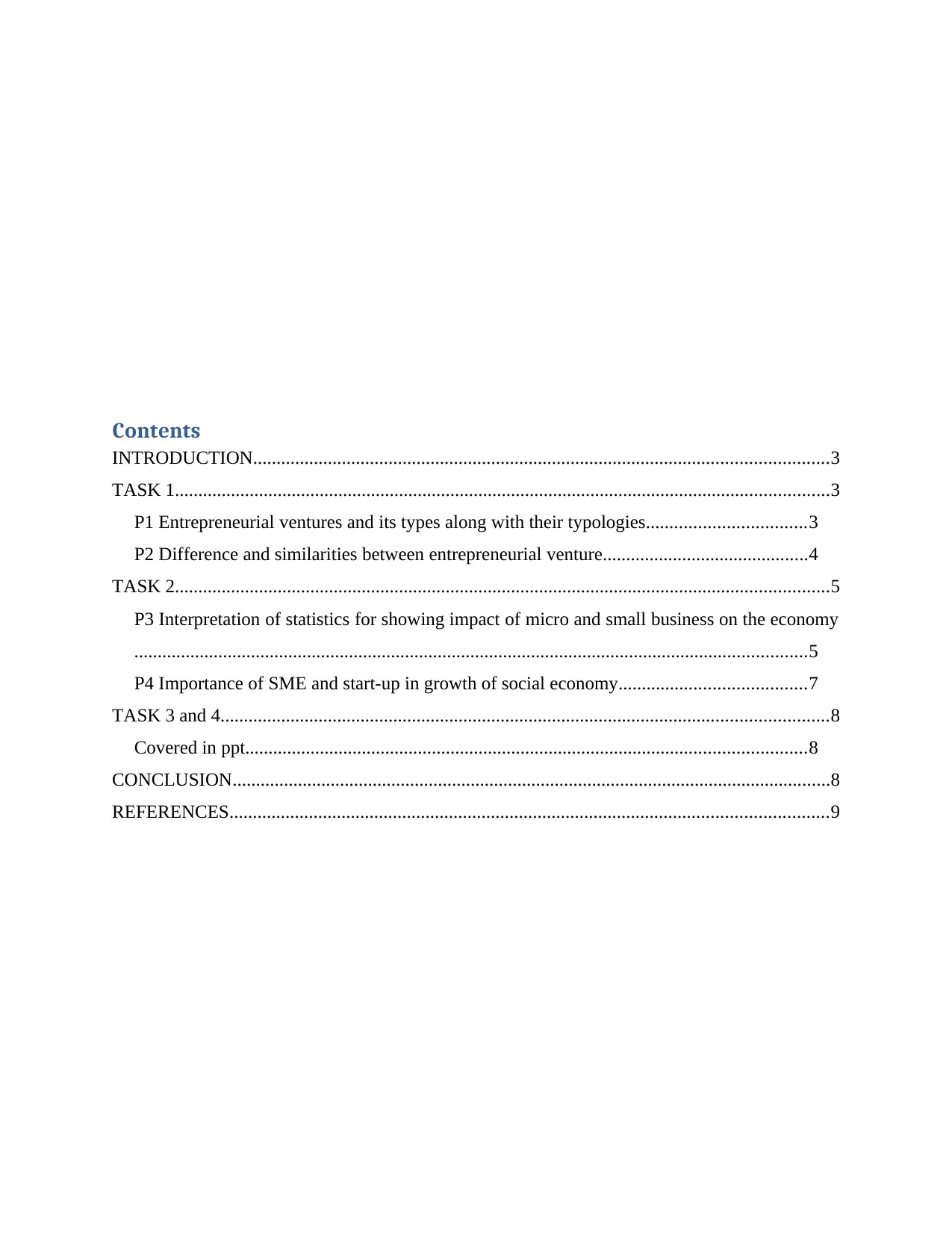
Contents
INTRODUCTION...........................................................................................................................3
TASK 1............................................................................................................................................3
P1 Entrepreneurial ventures and its types along with their typologies..................................3
P2 Difference and similarities between entrepreneurial venture............................................4
TASK 2............................................................................................................................................5
P3 Interpretation of statistics for showing impact of micro and small business on the economy
................................................................................................................................................5
P4 Importance of SME and start-up in growth of social economy........................................7
TASK 3 and 4..................................................................................................................................8
Covered in ppt........................................................................................................................8
CONCLUSION................................................................................................................................8
REFERENCES................................................................................................................................9
INTRODUCTION...........................................................................................................................3
TASK 1............................................................................................................................................3
P1 Entrepreneurial ventures and its types along with their typologies..................................3
P2 Difference and similarities between entrepreneurial venture............................................4
TASK 2............................................................................................................................................5
P3 Interpretation of statistics for showing impact of micro and small business on the economy
................................................................................................................................................5
P4 Importance of SME and start-up in growth of social economy........................................7
TASK 3 and 4..................................................................................................................................8
Covered in ppt........................................................................................................................8
CONCLUSION................................................................................................................................8
REFERENCES................................................................................................................................9
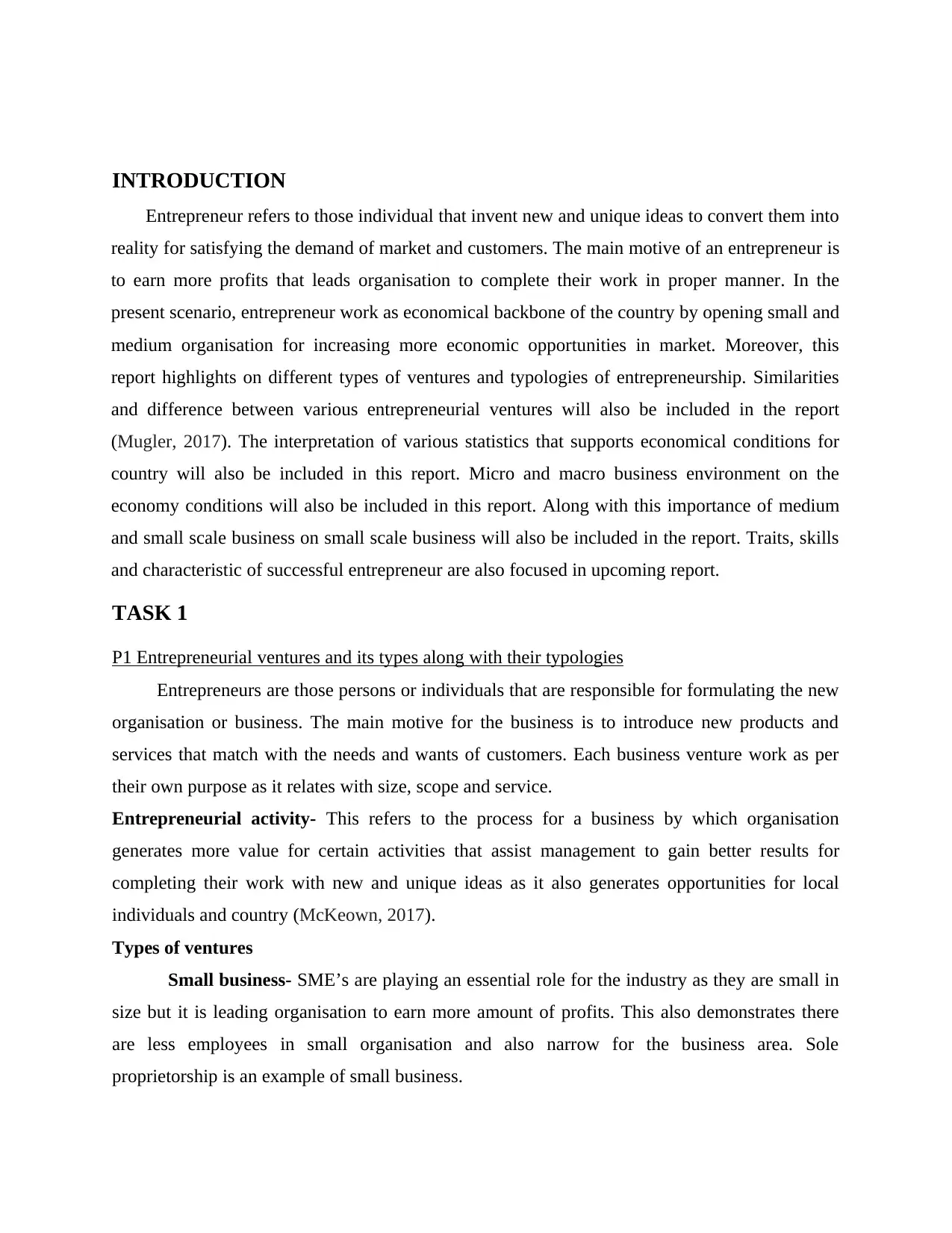
INTRODUCTION
Entrepreneur refers to those individual that invent new and unique ideas to convert them into
reality for satisfying the demand of market and customers. The main motive of an entrepreneur is
to earn more profits that leads organisation to complete their work in proper manner. In the
present scenario, entrepreneur work as economical backbone of the country by opening small and
medium organisation for increasing more economic opportunities in market. Moreover, this
report highlights on different types of ventures and typologies of entrepreneurship. Similarities
and difference between various entrepreneurial ventures will also be included in the report
(Mugler, 2017). The interpretation of various statistics that supports economical conditions for
country will also be included in this report. Micro and macro business environment on the
economy conditions will also be included in this report. Along with this importance of medium
and small scale business on small scale business will also be included in the report. Traits, skills
and characteristic of successful entrepreneur are also focused in upcoming report.
TASK 1
P1 Entrepreneurial ventures and its types along with their typologies
Entrepreneurs are those persons or individuals that are responsible for formulating the new
organisation or business. The main motive for the business is to introduce new products and
services that match with the needs and wants of customers. Each business venture work as per
their own purpose as it relates with size, scope and service.
Entrepreneurial activity- This refers to the process for a business by which organisation
generates more value for certain activities that assist management to gain better results for
completing their work with new and unique ideas as it also generates opportunities for local
individuals and country (McKeown, 2017).
Types of ventures
Small business- SME’s are playing an essential role for the industry as they are small in
size but it is leading organisation to earn more amount of profits. This also demonstrates there
are less employees in small organisation and also narrow for the business area. Sole
proprietorship is an example of small business.
Entrepreneur refers to those individual that invent new and unique ideas to convert them into
reality for satisfying the demand of market and customers. The main motive of an entrepreneur is
to earn more profits that leads organisation to complete their work in proper manner. In the
present scenario, entrepreneur work as economical backbone of the country by opening small and
medium organisation for increasing more economic opportunities in market. Moreover, this
report highlights on different types of ventures and typologies of entrepreneurship. Similarities
and difference between various entrepreneurial ventures will also be included in the report
(Mugler, 2017). The interpretation of various statistics that supports economical conditions for
country will also be included in this report. Micro and macro business environment on the
economy conditions will also be included in this report. Along with this importance of medium
and small scale business on small scale business will also be included in the report. Traits, skills
and characteristic of successful entrepreneur are also focused in upcoming report.
TASK 1
P1 Entrepreneurial ventures and its types along with their typologies
Entrepreneurs are those persons or individuals that are responsible for formulating the new
organisation or business. The main motive for the business is to introduce new products and
services that match with the needs and wants of customers. Each business venture work as per
their own purpose as it relates with size, scope and service.
Entrepreneurial activity- This refers to the process for a business by which organisation
generates more value for certain activities that assist management to gain better results for
completing their work with new and unique ideas as it also generates opportunities for local
individuals and country (McKeown, 2017).
Types of ventures
Small business- SME’s are playing an essential role for the industry as they are small in
size but it is leading organisation to earn more amount of profits. This also demonstrates there
are less employees in small organisation and also narrow for the business area. Sole
proprietorship is an example of small business.
⊘ This is a preview!⊘
Do you want full access?
Subscribe today to unlock all pages.

Trusted by 1+ million students worldwide
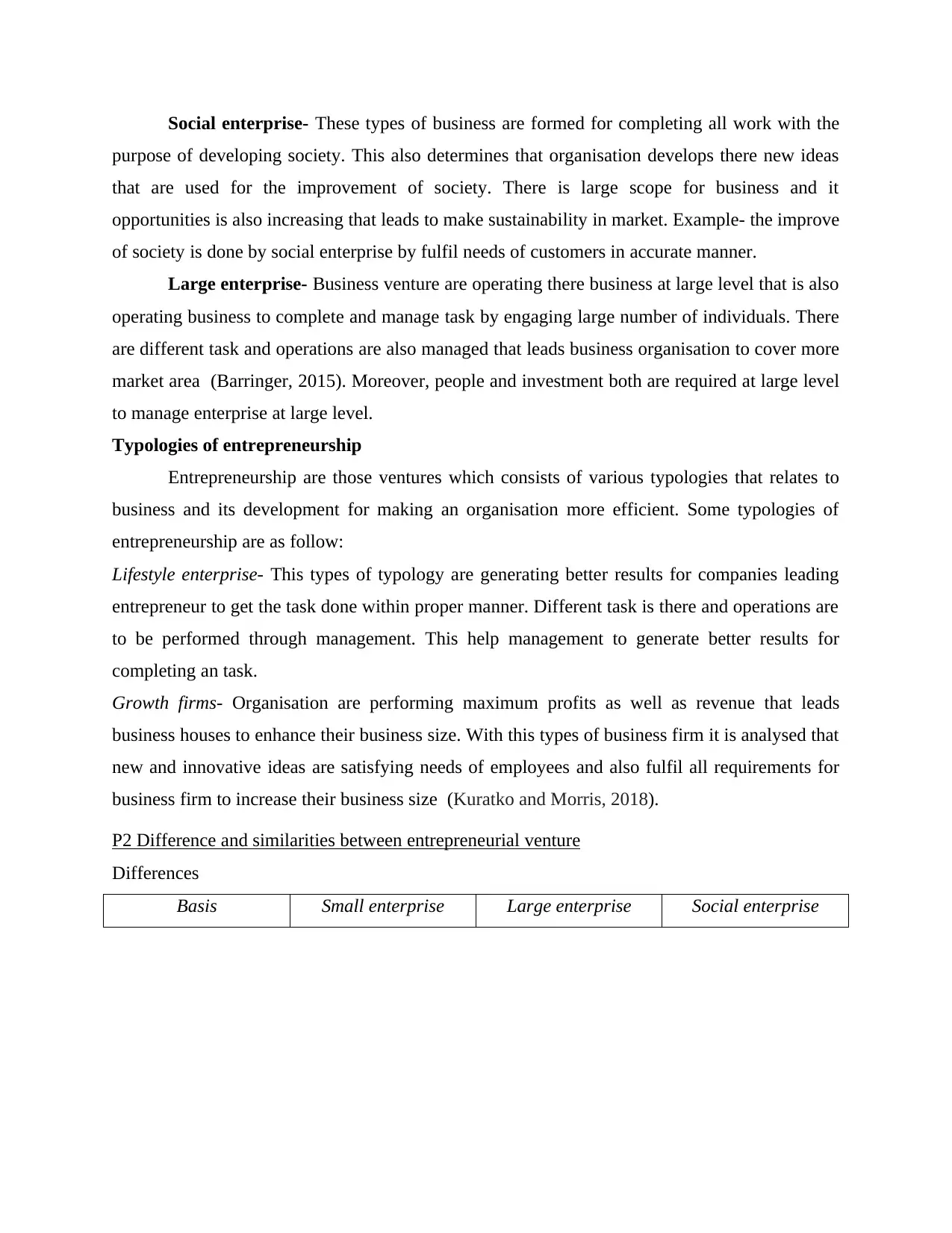
Social enterprise- These types of business are formed for completing all work with the
purpose of developing society. This also determines that organisation develops there new ideas
that are used for the improvement of society. There is large scope for business and it
opportunities is also increasing that leads to make sustainability in market. Example- the improve
of society is done by social enterprise by fulfil needs of customers in accurate manner.
Large enterprise- Business venture are operating there business at large level that is also
operating business to complete and manage task by engaging large number of individuals. There
are different task and operations are also managed that leads business organisation to cover more
market area (Barringer, 2015). Moreover, people and investment both are required at large level
to manage enterprise at large level.
Typologies of entrepreneurship
Entrepreneurship are those ventures which consists of various typologies that relates to
business and its development for making an organisation more efficient. Some typologies of
entrepreneurship are as follow:
Lifestyle enterprise- This types of typology are generating better results for companies leading
entrepreneur to get the task done within proper manner. Different task is there and operations are
to be performed through management. This help management to generate better results for
completing an task.
Growth firms- Organisation are performing maximum profits as well as revenue that leads
business houses to enhance their business size. With this types of business firm it is analysed that
new and innovative ideas are satisfying needs of employees and also fulfil all requirements for
business firm to increase their business size (Kuratko and Morris, 2018).
P2 Difference and similarities between entrepreneurial venture
Differences
Basis Small enterprise Large enterprise Social enterprise
purpose of developing society. This also determines that organisation develops there new ideas
that are used for the improvement of society. There is large scope for business and it
opportunities is also increasing that leads to make sustainability in market. Example- the improve
of society is done by social enterprise by fulfil needs of customers in accurate manner.
Large enterprise- Business venture are operating there business at large level that is also
operating business to complete and manage task by engaging large number of individuals. There
are different task and operations are also managed that leads business organisation to cover more
market area (Barringer, 2015). Moreover, people and investment both are required at large level
to manage enterprise at large level.
Typologies of entrepreneurship
Entrepreneurship are those ventures which consists of various typologies that relates to
business and its development for making an organisation more efficient. Some typologies of
entrepreneurship are as follow:
Lifestyle enterprise- This types of typology are generating better results for companies leading
entrepreneur to get the task done within proper manner. Different task is there and operations are
to be performed through management. This help management to generate better results for
completing an task.
Growth firms- Organisation are performing maximum profits as well as revenue that leads
business houses to enhance their business size. With this types of business firm it is analysed that
new and innovative ideas are satisfying needs of employees and also fulfil all requirements for
business firm to increase their business size (Kuratko and Morris, 2018).
P2 Difference and similarities between entrepreneurial venture
Differences
Basis Small enterprise Large enterprise Social enterprise
Paraphrase This Document
Need a fresh take? Get an instant paraphrase of this document with our AI Paraphraser
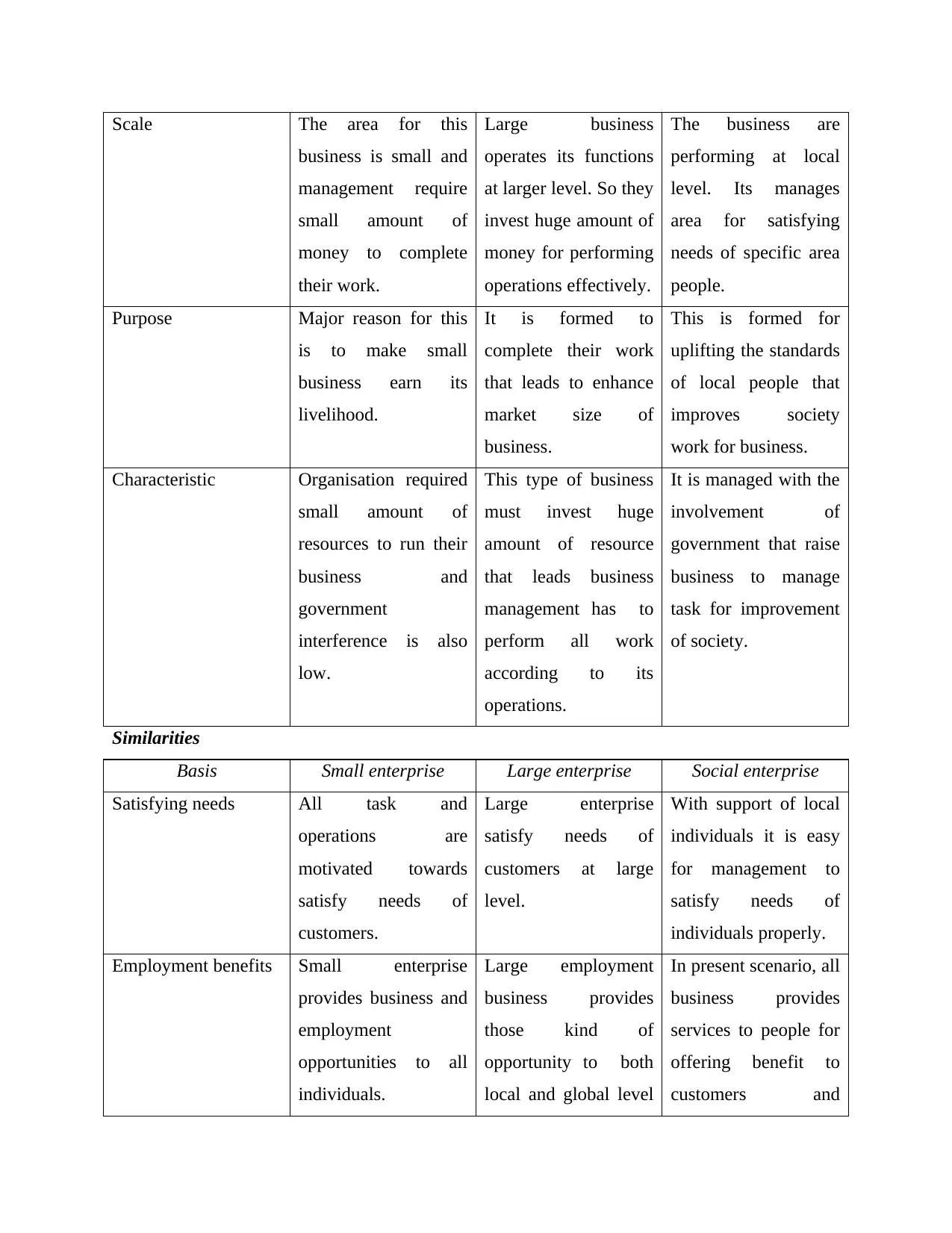
Scale The area for this
business is small and
management require
small amount of
money to complete
their work.
Large business
operates its functions
at larger level. So they
invest huge amount of
money for performing
operations effectively.
The business are
performing at local
level. Its manages
area for satisfying
needs of specific area
people.
Purpose Major reason for this
is to make small
business earn its
livelihood.
It is formed to
complete their work
that leads to enhance
market size of
business.
This is formed for
uplifting the standards
of local people that
improves society
work for business.
Characteristic Organisation required
small amount of
resources to run their
business and
government
interference is also
low.
This type of business
must invest huge
amount of resource
that leads business
management has to
perform all work
according to its
operations.
It is managed with the
involvement of
government that raise
business to manage
task for improvement
of society.
Similarities
Basis Small enterprise Large enterprise Social enterprise
Satisfying needs All task and
operations are
motivated towards
satisfy needs of
customers.
Large enterprise
satisfy needs of
customers at large
level.
With support of local
individuals it is easy
for management to
satisfy needs of
individuals properly.
Employment benefits Small enterprise
provides business and
employment
opportunities to all
individuals.
Large employment
business provides
those kind of
opportunity to both
local and global level
In present scenario, all
business provides
services to people for
offering benefit to
customers and
business is small and
management require
small amount of
money to complete
their work.
Large business
operates its functions
at larger level. So they
invest huge amount of
money for performing
operations effectively.
The business are
performing at local
level. Its manages
area for satisfying
needs of specific area
people.
Purpose Major reason for this
is to make small
business earn its
livelihood.
It is formed to
complete their work
that leads to enhance
market size of
business.
This is formed for
uplifting the standards
of local people that
improves society
work for business.
Characteristic Organisation required
small amount of
resources to run their
business and
government
interference is also
low.
This type of business
must invest huge
amount of resource
that leads business
management has to
perform all work
according to its
operations.
It is managed with the
involvement of
government that raise
business to manage
task for improvement
of society.
Similarities
Basis Small enterprise Large enterprise Social enterprise
Satisfying needs All task and
operations are
motivated towards
satisfy needs of
customers.
Large enterprise
satisfy needs of
customers at large
level.
With support of local
individuals it is easy
for management to
satisfy needs of
individuals properly.
Employment benefits Small enterprise
provides business and
employment
opportunities to all
individuals.
Large employment
business provides
those kind of
opportunity to both
local and global level
In present scenario, all
business provides
services to people for
offering benefit to
customers and
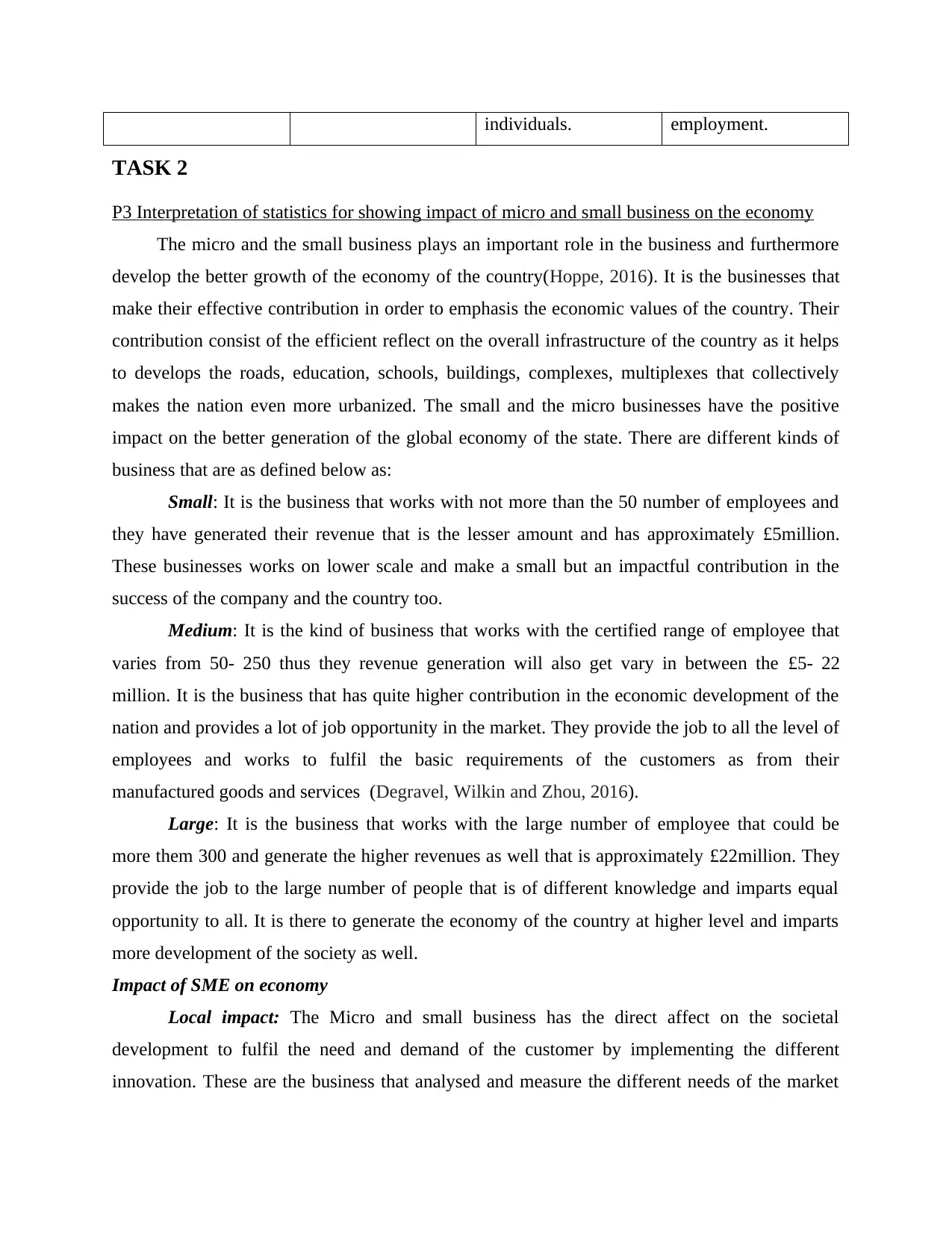
individuals. employment.
TASK 2
P3 Interpretation of statistics for showing impact of micro and small business on the economy
The micro and the small business plays an important role in the business and furthermore
develop the better growth of the economy of the country(Hoppe, 2016). It is the businesses that
make their effective contribution in order to emphasis the economic values of the country. Their
contribution consist of the efficient reflect on the overall infrastructure of the country as it helps
to develops the roads, education, schools, buildings, complexes, multiplexes that collectively
makes the nation even more urbanized. The small and the micro businesses have the positive
impact on the better generation of the global economy of the state. There are different kinds of
business that are as defined below as:
Small: It is the business that works with not more than the 50 number of employees and
they have generated their revenue that is the lesser amount and has approximately £5million.
These businesses works on lower scale and make a small but an impactful contribution in the
success of the company and the country too.
Medium: It is the kind of business that works with the certified range of employee that
varies from 50- 250 thus they revenue generation will also get vary in between the £5- 22
million. It is the business that has quite higher contribution in the economic development of the
nation and provides a lot of job opportunity in the market. They provide the job to all the level of
employees and works to fulfil the basic requirements of the customers as from their
manufactured goods and services (Degravel, Wilkin and Zhou, 2016).
Large: It is the business that works with the large number of employee that could be
more them 300 and generate the higher revenues as well that is approximately £22million. They
provide the job to the large number of people that is of different knowledge and imparts equal
opportunity to all. It is there to generate the economy of the country at higher level and imparts
more development of the society as well.
Impact of SME on economy
Local impact: The Micro and small business has the direct affect on the societal
development to fulfil the need and demand of the customer by implementing the different
innovation. These are the business that analysed and measure the different needs of the market
TASK 2
P3 Interpretation of statistics for showing impact of micro and small business on the economy
The micro and the small business plays an important role in the business and furthermore
develop the better growth of the economy of the country(Hoppe, 2016). It is the businesses that
make their effective contribution in order to emphasis the economic values of the country. Their
contribution consist of the efficient reflect on the overall infrastructure of the country as it helps
to develops the roads, education, schools, buildings, complexes, multiplexes that collectively
makes the nation even more urbanized. The small and the micro businesses have the positive
impact on the better generation of the global economy of the state. There are different kinds of
business that are as defined below as:
Small: It is the business that works with not more than the 50 number of employees and
they have generated their revenue that is the lesser amount and has approximately £5million.
These businesses works on lower scale and make a small but an impactful contribution in the
success of the company and the country too.
Medium: It is the kind of business that works with the certified range of employee that
varies from 50- 250 thus they revenue generation will also get vary in between the £5- 22
million. It is the business that has quite higher contribution in the economic development of the
nation and provides a lot of job opportunity in the market. They provide the job to all the level of
employees and works to fulfil the basic requirements of the customers as from their
manufactured goods and services (Degravel, Wilkin and Zhou, 2016).
Large: It is the business that works with the large number of employee that could be
more them 300 and generate the higher revenues as well that is approximately £22million. They
provide the job to the large number of people that is of different knowledge and imparts equal
opportunity to all. It is there to generate the economy of the country at higher level and imparts
more development of the society as well.
Impact of SME on economy
Local impact: The Micro and small business has the direct affect on the societal
development to fulfil the need and demand of the customer by implementing the different
innovation. These are the business that analysed and measure the different needs of the market
⊘ This is a preview!⊘
Do you want full access?
Subscribe today to unlock all pages.

Trusted by 1+ million students worldwide
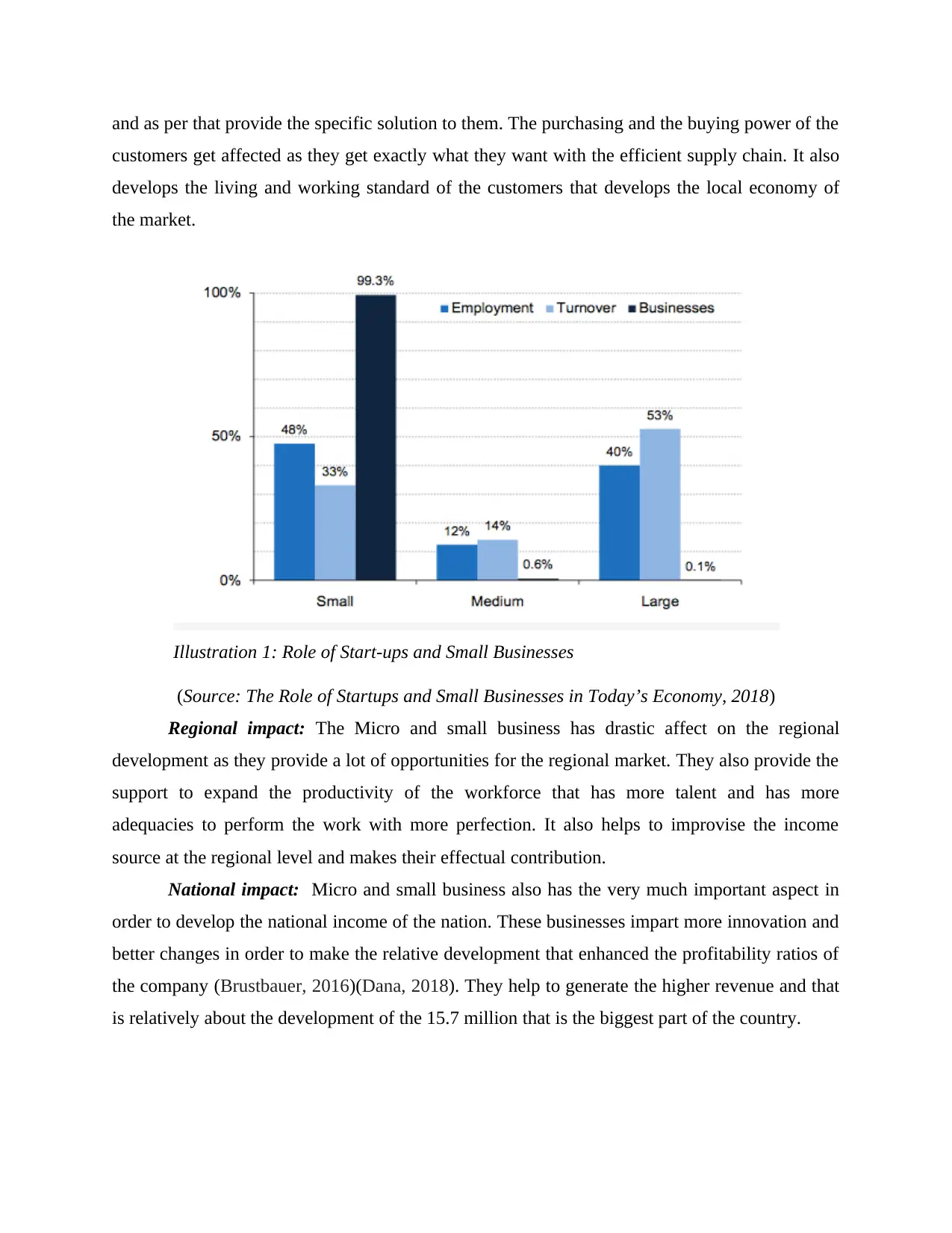
and as per that provide the specific solution to them. The purchasing and the buying power of the
customers get affected as they get exactly what they want with the efficient supply chain. It also
develops the living and working standard of the customers that develops the local economy of
the market.
(Source: The Role of Startups and Small Businesses in Today’s Economy, 2018)
Regional impact: The Micro and small business has drastic affect on the regional
development as they provide a lot of opportunities for the regional market. They also provide the
support to expand the productivity of the workforce that has more talent and has more
adequacies to perform the work with more perfection. It also helps to improvise the income
source at the regional level and makes their effectual contribution.
National impact: Micro and small business also has the very much important aspect in
order to develop the national income of the nation. These businesses impart more innovation and
better changes in order to make the relative development that enhanced the profitability ratios of
the company (Brustbauer, 2016)(Dana, 2018). They help to generate the higher revenue and that
is relatively about the development of the 15.7 million that is the biggest part of the country.
Illustration 1: Role of Start-ups and Small Businesses
customers get affected as they get exactly what they want with the efficient supply chain. It also
develops the living and working standard of the customers that develops the local economy of
the market.
(Source: The Role of Startups and Small Businesses in Today’s Economy, 2018)
Regional impact: The Micro and small business has drastic affect on the regional
development as they provide a lot of opportunities for the regional market. They also provide the
support to expand the productivity of the workforce that has more talent and has more
adequacies to perform the work with more perfection. It also helps to improvise the income
source at the regional level and makes their effectual contribution.
National impact: Micro and small business also has the very much important aspect in
order to develop the national income of the nation. These businesses impart more innovation and
better changes in order to make the relative development that enhanced the profitability ratios of
the company (Brustbauer, 2016)(Dana, 2018). They help to generate the higher revenue and that
is relatively about the development of the 15.7 million that is the biggest part of the country.
Illustration 1: Role of Start-ups and Small Businesses
Paraphrase This Document
Need a fresh take? Get an instant paraphrase of this document with our AI Paraphraser
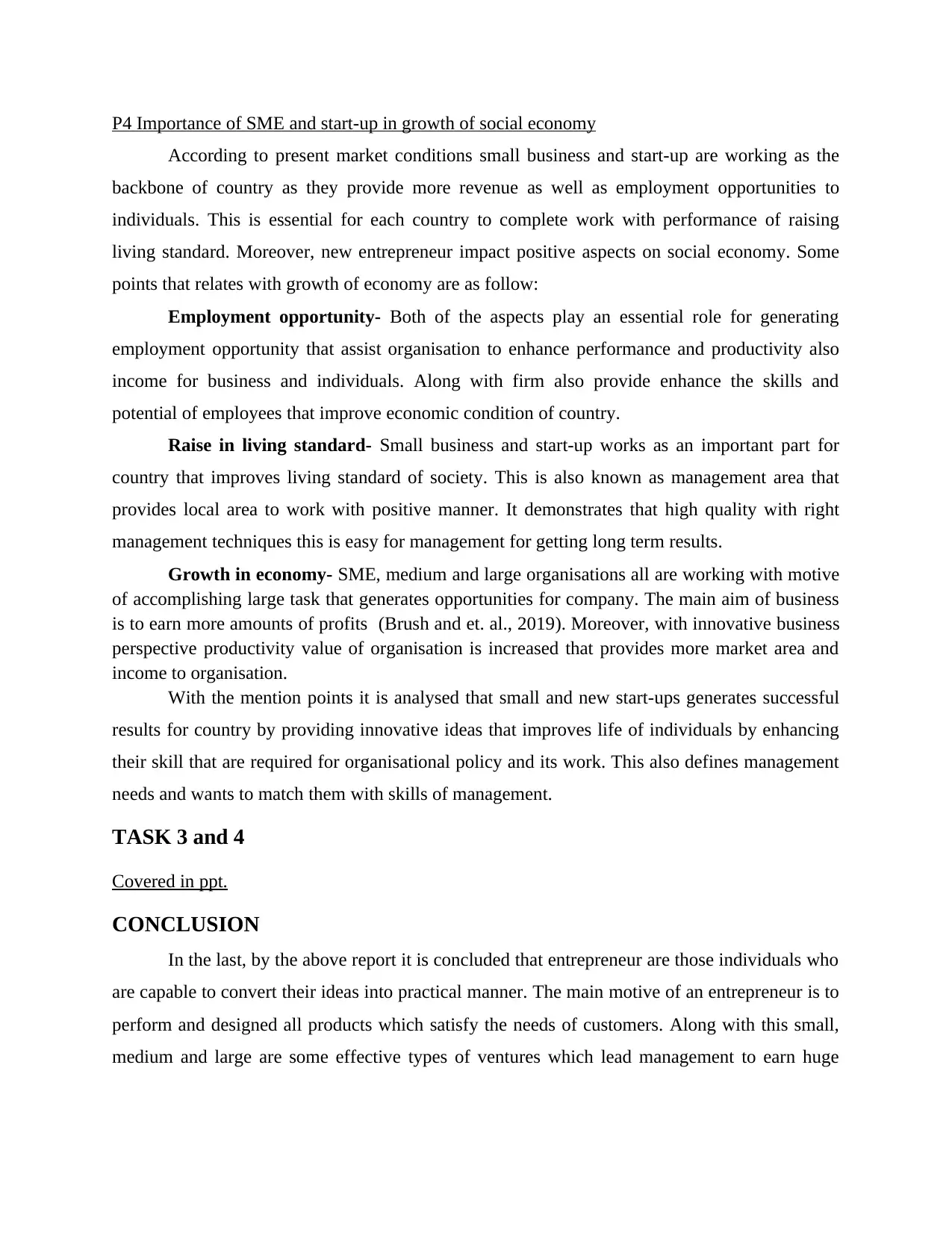
P4 Importance of SME and start-up in growth of social economy
According to present market conditions small business and start-up are working as the
backbone of country as they provide more revenue as well as employment opportunities to
individuals. This is essential for each country to complete work with performance of raising
living standard. Moreover, new entrepreneur impact positive aspects on social economy. Some
points that relates with growth of economy are as follow:
Employment opportunity- Both of the aspects play an essential role for generating
employment opportunity that assist organisation to enhance performance and productivity also
income for business and individuals. Along with firm also provide enhance the skills and
potential of employees that improve economic condition of country.
Raise in living standard- Small business and start-up works as an important part for
country that improves living standard of society. This is also known as management area that
provides local area to work with positive manner. It demonstrates that high quality with right
management techniques this is easy for management for getting long term results.
Growth in economy- SME, medium and large organisations all are working with motive
of accomplishing large task that generates opportunities for company. The main aim of business
is to earn more amounts of profits (Brush and et. al., 2019). Moreover, with innovative business
perspective productivity value of organisation is increased that provides more market area and
income to organisation.
With the mention points it is analysed that small and new start-ups generates successful
results for country by providing innovative ideas that improves life of individuals by enhancing
their skill that are required for organisational policy and its work. This also defines management
needs and wants to match them with skills of management.
TASK 3 and 4
Covered in ppt.
CONCLUSION
In the last, by the above report it is concluded that entrepreneur are those individuals who
are capable to convert their ideas into practical manner. The main motive of an entrepreneur is to
perform and designed all products which satisfy the needs of customers. Along with this small,
medium and large are some effective types of ventures which lead management to earn huge
According to present market conditions small business and start-up are working as the
backbone of country as they provide more revenue as well as employment opportunities to
individuals. This is essential for each country to complete work with performance of raising
living standard. Moreover, new entrepreneur impact positive aspects on social economy. Some
points that relates with growth of economy are as follow:
Employment opportunity- Both of the aspects play an essential role for generating
employment opportunity that assist organisation to enhance performance and productivity also
income for business and individuals. Along with firm also provide enhance the skills and
potential of employees that improve economic condition of country.
Raise in living standard- Small business and start-up works as an important part for
country that improves living standard of society. This is also known as management area that
provides local area to work with positive manner. It demonstrates that high quality with right
management techniques this is easy for management for getting long term results.
Growth in economy- SME, medium and large organisations all are working with motive
of accomplishing large task that generates opportunities for company. The main aim of business
is to earn more amounts of profits (Brush and et. al., 2019). Moreover, with innovative business
perspective productivity value of organisation is increased that provides more market area and
income to organisation.
With the mention points it is analysed that small and new start-ups generates successful
results for country by providing innovative ideas that improves life of individuals by enhancing
their skill that are required for organisational policy and its work. This also defines management
needs and wants to match them with skills of management.
TASK 3 and 4
Covered in ppt.
CONCLUSION
In the last, by the above report it is concluded that entrepreneur are those individuals who
are capable to convert their ideas into practical manner. The main motive of an entrepreneur is to
perform and designed all products which satisfy the needs of customers. Along with this small,
medium and large are some effective types of ventures which lead management to earn huge

amount of profits. Along with this new business organisation also generating various
opportunities that leads business to generates different benefits for workforce and society.
opportunities that leads business to generates different benefits for workforce and society.
⊘ This is a preview!⊘
Do you want full access?
Subscribe today to unlock all pages.

Trusted by 1+ million students worldwide
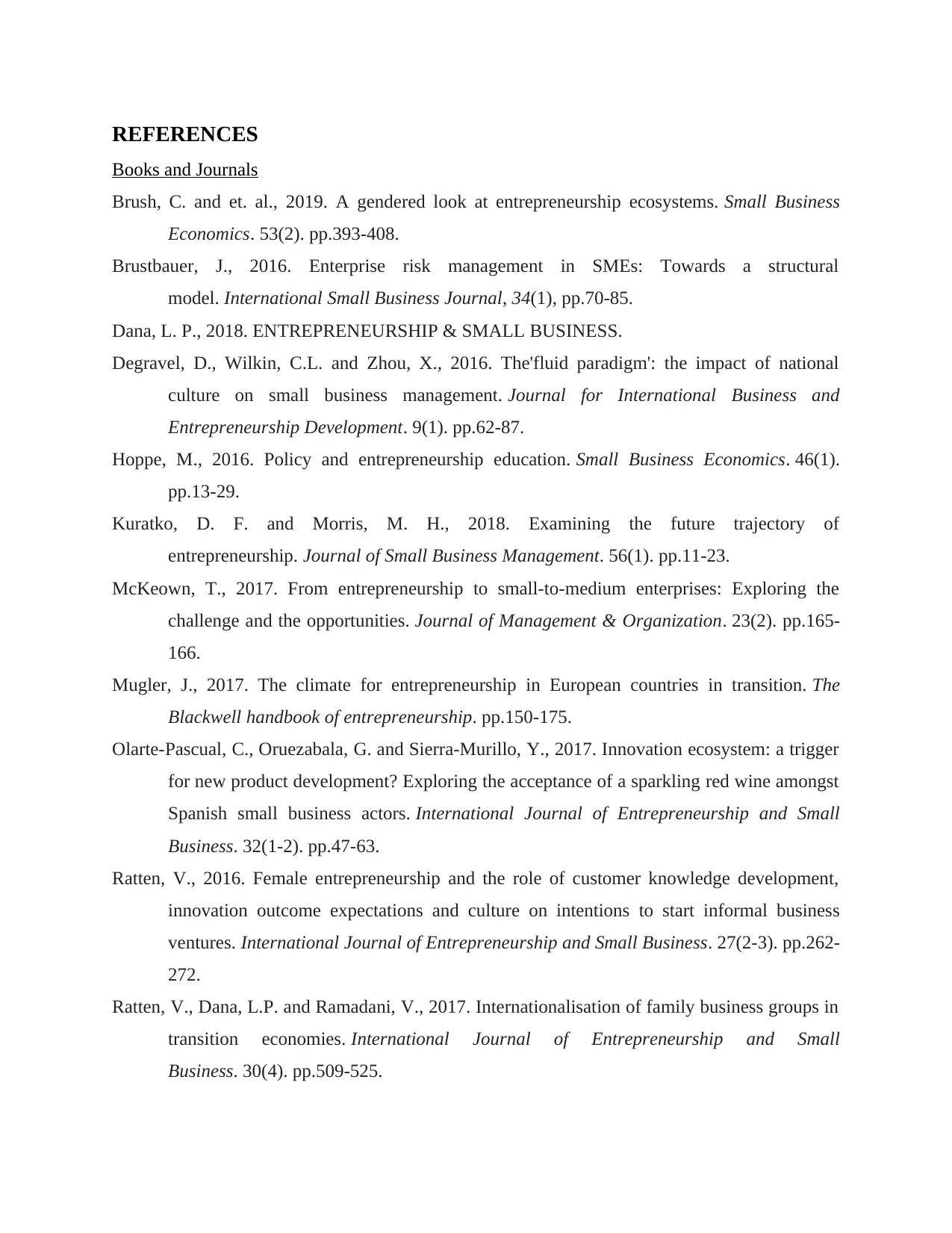
REFERENCES
Books and Journals
Brush, C. and et. al., 2019. A gendered look at entrepreneurship ecosystems. Small Business
Economics. 53(2). pp.393-408.
Brustbauer, J., 2016. Enterprise risk management in SMEs: Towards a structural
model. International Small Business Journal, 34(1), pp.70-85.
Dana, L. P., 2018. ENTREPRENEURSHIP & SMALL BUSINESS.
Degravel, D., Wilkin, C.L. and Zhou, X., 2016. The'fluid paradigm': the impact of national
culture on small business management. Journal for International Business and
Entrepreneurship Development. 9(1). pp.62-87.
Hoppe, M., 2016. Policy and entrepreneurship education. Small Business Economics. 46(1).
pp.13-29.
Kuratko, D. F. and Morris, M. H., 2018. Examining the future trajectory of
entrepreneurship. Journal of Small Business Management. 56(1). pp.11-23.
McKeown, T., 2017. From entrepreneurship to small-to-medium enterprises: Exploring the
challenge and the opportunities. Journal of Management & Organization. 23(2). pp.165-
166.
Mugler, J., 2017. The climate for entrepreneurship in European countries in transition. The
Blackwell handbook of entrepreneurship. pp.150-175.
Olarte-Pascual, C., Oruezabala, G. and Sierra-Murillo, Y., 2017. Innovation ecosystem: a trigger
for new product development? Exploring the acceptance of a sparkling red wine amongst
Spanish small business actors. International Journal of Entrepreneurship and Small
Business. 32(1-2). pp.47-63.
Ratten, V., 2016. Female entrepreneurship and the role of customer knowledge development,
innovation outcome expectations and culture on intentions to start informal business
ventures. International Journal of Entrepreneurship and Small Business. 27(2-3). pp.262-
272.
Ratten, V., Dana, L.P. and Ramadani, V., 2017. Internationalisation of family business groups in
transition economies. International Journal of Entrepreneurship and Small
Business. 30(4). pp.509-525.
Books and Journals
Brush, C. and et. al., 2019. A gendered look at entrepreneurship ecosystems. Small Business
Economics. 53(2). pp.393-408.
Brustbauer, J., 2016. Enterprise risk management in SMEs: Towards a structural
model. International Small Business Journal, 34(1), pp.70-85.
Dana, L. P., 2018. ENTREPRENEURSHIP & SMALL BUSINESS.
Degravel, D., Wilkin, C.L. and Zhou, X., 2016. The'fluid paradigm': the impact of national
culture on small business management. Journal for International Business and
Entrepreneurship Development. 9(1). pp.62-87.
Hoppe, M., 2016. Policy and entrepreneurship education. Small Business Economics. 46(1).
pp.13-29.
Kuratko, D. F. and Morris, M. H., 2018. Examining the future trajectory of
entrepreneurship. Journal of Small Business Management. 56(1). pp.11-23.
McKeown, T., 2017. From entrepreneurship to small-to-medium enterprises: Exploring the
challenge and the opportunities. Journal of Management & Organization. 23(2). pp.165-
166.
Mugler, J., 2017. The climate for entrepreneurship in European countries in transition. The
Blackwell handbook of entrepreneurship. pp.150-175.
Olarte-Pascual, C., Oruezabala, G. and Sierra-Murillo, Y., 2017. Innovation ecosystem: a trigger
for new product development? Exploring the acceptance of a sparkling red wine amongst
Spanish small business actors. International Journal of Entrepreneurship and Small
Business. 32(1-2). pp.47-63.
Ratten, V., 2016. Female entrepreneurship and the role of customer knowledge development,
innovation outcome expectations and culture on intentions to start informal business
ventures. International Journal of Entrepreneurship and Small Business. 27(2-3). pp.262-
272.
Ratten, V., Dana, L.P. and Ramadani, V., 2017. Internationalisation of family business groups in
transition economies. International Journal of Entrepreneurship and Small
Business. 30(4). pp.509-525.
Paraphrase This Document
Need a fresh take? Get an instant paraphrase of this document with our AI Paraphraser
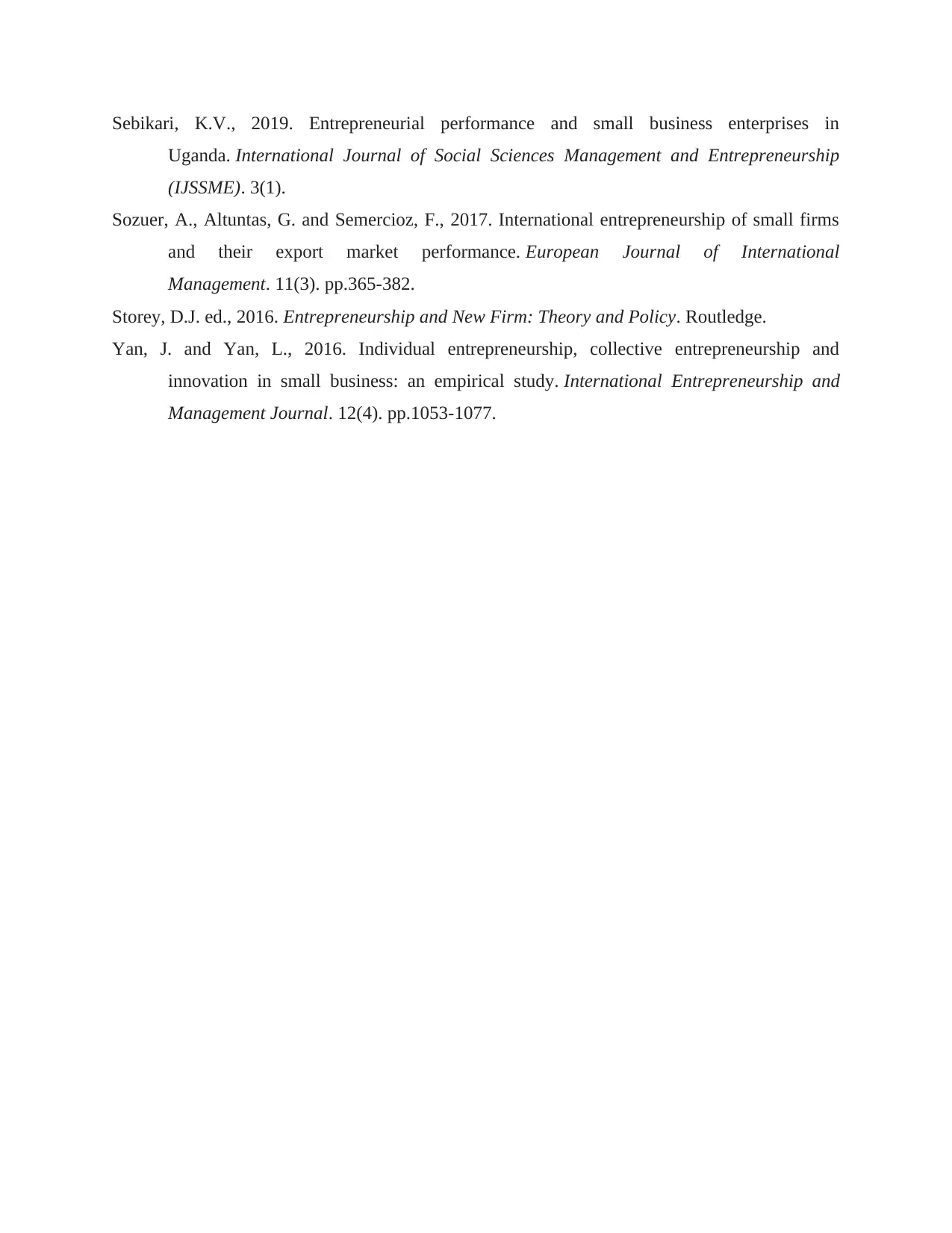
Sebikari, K.V., 2019. Entrepreneurial performance and small business enterprises in
Uganda. International Journal of Social Sciences Management and Entrepreneurship
(IJSSME). 3(1).
Sozuer, A., Altuntas, G. and Semercioz, F., 2017. International entrepreneurship of small firms
and their export market performance. European Journal of International
Management. 11(3). pp.365-382.
Storey, D.J. ed., 2016. Entrepreneurship and New Firm: Theory and Policy. Routledge.
Yan, J. and Yan, L., 2016. Individual entrepreneurship, collective entrepreneurship and
innovation in small business: an empirical study. International Entrepreneurship and
Management Journal. 12(4). pp.1053-1077.
Uganda. International Journal of Social Sciences Management and Entrepreneurship
(IJSSME). 3(1).
Sozuer, A., Altuntas, G. and Semercioz, F., 2017. International entrepreneurship of small firms
and their export market performance. European Journal of International
Management. 11(3). pp.365-382.
Storey, D.J. ed., 2016. Entrepreneurship and New Firm: Theory and Policy. Routledge.
Yan, J. and Yan, L., 2016. Individual entrepreneurship, collective entrepreneurship and
innovation in small business: an empirical study. International Entrepreneurship and
Management Journal. 12(4). pp.1053-1077.
1 out of 11
Related Documents
Your All-in-One AI-Powered Toolkit for Academic Success.
+13062052269
info@desklib.com
Available 24*7 on WhatsApp / Email
![[object Object]](/_next/static/media/star-bottom.7253800d.svg)
Unlock your academic potential
Copyright © 2020–2025 A2Z Services. All Rights Reserved. Developed and managed by ZUCOL.



